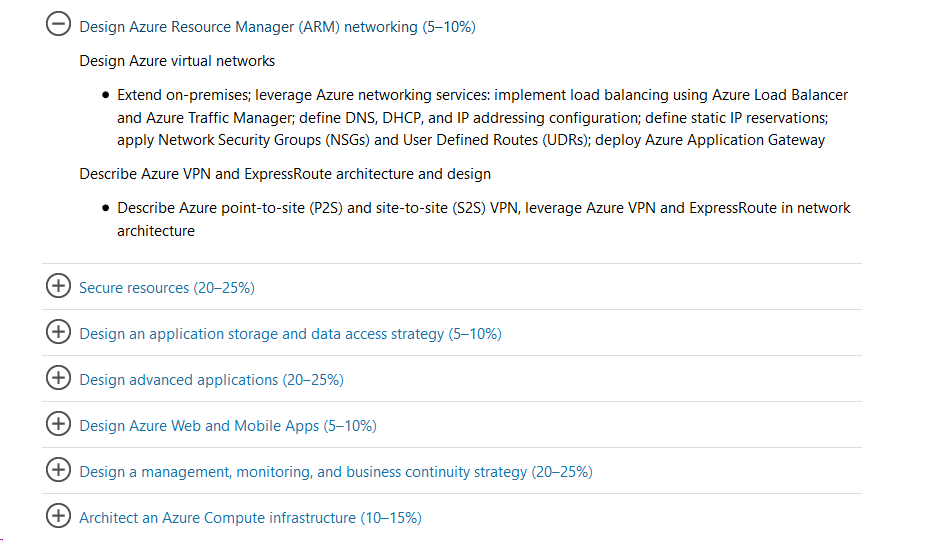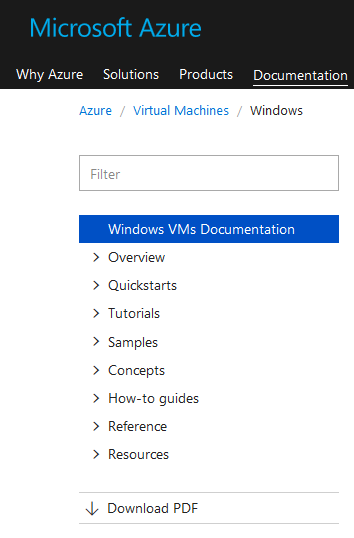Exam prep for Architecting Microsoft Azure Solutions, 70-534
So you are thinking about taking the 534 exam, Architecting Microsoft Azure Solutions.
There are plenty of exam prep resources and courses out there from Udemy\Pluralsight courses, books, guides, etc. Doing a web search returned 227,000 search results for "Azure 70-534 certification". With all these different resources, whats a good place to start?
Lets take a look at the exam listing page on the Microsoft Learning site. Each Microsoft exam page has a Skills Measured section. This section clearly outlines the knowledge that will be measured on the exam. i.e. the exam questions are going to be about the following topics only.
I was going through the listings above, and noticed that they seemed to clearly match up to documentation on azure.microsoft.com. There almost was a 1:1 correlation to the Azure documentation. As I was preparing for the exam, I went through each skill being measured and made sure that I had a good understanding of the concepts.
(As an aside, I do want to give a shout out to the Azure Technical writers. They have done a fantastic job of structuring the documentation, and keeping it consistent across all the different services. This makes it very easy to quickly learn about the service and get started right away.)
After writing the exam, I found the above approach to work really well. I have shared this with a few colleagues and customers, and each had rave reviews about how easy it was to study for the exam.
Other Prep Notes
- Dont spend time reading through the text on scenario questions. Skip to the first question, and then come back to the text to dig out the answers.
- Track your time. You will have plenty of time to finish the exam, just dont get bogged down on questions.
534 Skills Measured and Links
To make it even easier, I scraped all the Skills Measured on the 534 page, and have attempted to hyperlink them to their corresponding webpage on the Azure site. Hopefully this makes it even easier for you to study and get certified.
- Design Azure Resource Manager (ARM) networking (5–10%)
- Design Azure virtual networks
- Extend on-premises;
- Leverage Azure networking services: implement load balancing using Azure Load Balancer and Azure Traffic Manager;
- define DNS, DHCP, and IP addressing configuration; - Link2
- define static IP reservations; - Link2
- apply Network Security Groups (NSGs) and User Defined Routes (UDRs);
- deploy Azure Application Gateway – Link2
- Describe Azure VPN and ExpressRoute architecture and design
- Design Azure virtual networks
- Secure resources (20–25%)
- Secure resources by using managed identities
- Secure resources by using hybrid identities
- Secure resources by using identity providers
- Identify an appropriate data security solution
- Identify security requirements for data in transit and data at rest;
- identify security requirements using Azure services, including Azure Storage Encryption, Azure Disk Encryption, and Azure SQL Database TDE
- Design a role-based access control (RBAC) strategy
- Manage security risks by using an appropriate security solution
- Identify, assess, and mitigate security risks by using Azure Security Center, Operations Management Suite, and other services
- Design an application storage and data access strategy (5–10%)
- Design data storage
- Select the appropriate storage option
- Design advanced applications (20–25%)
- Create compute-intensive applications
- Create long-running applications
- Integrate Azure services in a solution
- Design Azure architecture using Azure services, such as Azure AD, Azure App Service, API Management, Azure Cache, Azure Search, Service Bus, Event Hubs, Stream Analytics, and IoT Hub; identify the appropriate use of Azure Machine Learning, big data, Azure Media Services, and Azure Search services
- Implement messaging applications
- Use a queue-centric pattern for development;
- select appropriate technology, such as Azure Storage Queues, Azure Service Bus queues, topics, subscriptions, and Azure Event Hubs
- Implement applications for background processing
- Design connectivity for hybrid applications
- Connect to on-premises data from Azure applications using Service Bus Relay, Hybrid Connections, or the Azure Web App virtual private network (VPN) capability;
- identify constraints for connectivity with VPN;
- identify options for joining VMs to domains or cloud services
- Design Azure Web and Mobile Apps (5–10%)
- Design Web Applications
- Design Azure App Service Web Apps,
- design custom web API,
- offload long-running applications using WebJobs,
- secure Web API using Azure AD,
- design Web Apps for scalability and performance, - Link2
- deploy Azure Web Apps to multiple regions for high availability, - Link2
- deploy Web Apps,
- create App Service plans,
- design Web Apps for business continuity,
- configure data replication patterns,
- update Azure Web Apps with minimal downtime,
- back up and restore data,
- design for disaster recovery
- Design Mobile Applications
- Design Azure Mobile Services;
- consume Mobile Apps from cross-platform clients;
- integrate offline sync capabilities into an application;
- extend Mobile Apps using custom code;
- implement Mobile Apps using Microsoft .NET or Node.js;
- secure Mobile Apps using Azure AD;
- implement push notification services in Mobile Apps;
- send push notifications to all subscribers, specific subscribers, or a segment of subscribers
- Design Web Applications
- Design a management, monitoring, and business continuity strategy (20–25%)
- Design a monitoring strategy
- Identify the Microsoft products and services for monitoring Azure solutions;
- leverage the capabilities of Azure Operations Management Suite and Azure Application Insights for monitoring Azure solutions;
- leverage built-in Azure capabilities;
- identify third-party monitoring tools, including open source;
- describe Azure architecture constructs, such as availability sets and update domains, and how they impact a patching strategy;
- analyze logs by using the Azure Operations Management Suite
- Describe Azure business continuity/disaster recovery (BC/DR) capabilities
- Design a disaster recovery strategy
- Design and deploy Azure Backup and other Microsoft backup solutions for Azure,
- leverage use cases when StorSimple and System Center Data Protection Manager would be appropriate,
- design and deploy Azure Site recovery – Link2 – Link3
- Design Azure Automation and PowerShell workflows – Link2
- Create a PowerShell script specific to Azure,
- automate tasks by using the Azure Operations Management Suite
- Describe the use cases for Azure Automation configuration
- Design a monitoring strategy
- Architect an Azure Compute infrastructure (10–15%)
- Design ARM Virtual Machines (VMs)
- Design ARM template deployment
- Design for availability
Comments
- Anonymous
May 14, 2017
The URL for describe ad connect synchronization is incorrect- Anonymous
May 14, 2017
Thanks for catching that Don. I updated the URL. Good luck with the prep. Let me know how it goes.
- Anonymous
- Anonymous
June 25, 2017
Excellent post Omer, thank you - it helped me immensely in my preparation for the exam. I have collated all the content from the URLs into a single PDF. https://blogs.msdn.microsoft.com/suhasaraos/2017/06/25/exam-preparation-guide-70-534-architecting-microsoft-azure-solutions/ - Anonymous
October 03, 2017
This is clutch!

